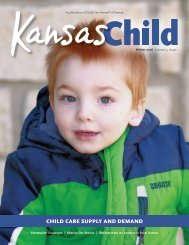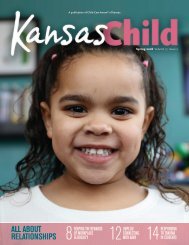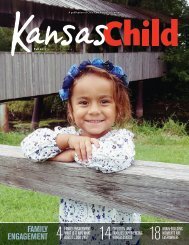2020 Summer Kansas Child
You also want an ePaper? Increase the reach of your titles
YUMPU automatically turns print PDFs into web optimized ePapers that Google loves.
others. Taking care of a plant or animal
can teach children the weight and responsibility
of caring for another being.
Gardening also can help build the socialemotional
skills children need before entering
elementary school and later as a
productive individual of the community.
Gardening can mean whatever you
would like it to mean. For me, gardening
is therapeutic, and after a long day, being
outside working in my garden is one of
the most relaxing places I can imagine.
Furthermore, since starting to garden, I
have cut down greatly on spending a large
amount of money on organic fruits and
vegetables to feed my family, which is another
very beneficial aspect of gardening.
People around the United States are
looking for outdoor and gardening opportunities
that are so easily accessible to
us in Kansas. I encourage you to take the
time to share these experiences with the
children in your life. It’s up to us to grow
a new generation of Kansans, and to
instill in them a love for gardening and
caring for their environment. I reflect
back to driving into Salina and think to
myself, “They even have cattle to learn
about every day!” I count myself lucky
to live in a state that provides the fertile
soil and opportunities to grow and raise
my children how I know so many people
across the country would like their children
to be raised.
1
https://www.cdc.gov/obesity/data/childhood.html
Photos by Desiree Streight
Child Care Provider in Kingman.
CHELSY SPILLER
Early Care Education
Specialist, Child Care
Aware® of Kansas
Mindfulness
“How many times have you noticed that it’s the little quiet moments in the midst of
life that seem to give the rest extra-special meaning?”
— Fred Rogers
BY JENNIFER PISHNY
Child care programs are usually active places, but children benefit from a balance between
active play and quiet activities. Many caregivers cherish the quiet moments of cuddle
time with a sleepy little one or sharing a favorite book with a small group. These moments
give meaning to a busy life, as Mister Rogers says, and are essential for long-term physical
and mental health (NIHCM, 2020). While moments of quiet are important, they don’t just
happen when children are told to “calm down.” Children develop self-regulation when they
learn to connect their mind and body, their thoughts and actions.
Before children can self-regulate, their caregivers need to regulate their own emotions.
During the first few years, children look to adults for behavior cues. Until they learn to
self-regulate, they might reflect the emotions of their caregivers. They also might resort to
a “freeze, fight or flight” response if they don’t see clear expectations. If the adults around
them raise their voices, children might freeze in fear, lash out at others physically or engage
in aimless activity. When you start to feel your own emotions becoming dysregulated, take
time to calm so you can respond to children’s needs and not react to their behavior. Mindfulness
is a technique to help you become aware of your feelings, a quick mental check-in.
With practice, you can calm your mind so you can respond with composure. (To learn more
about mindfulness, see Zero to Three Mindfulness Toolkit below.)
Mindfulness might come easy for you or might take practice, but it is a technique you
can also teach children. Even before they are able to understand and label feelings, they can
learn techniques to help them gain control. Deep breathing can help children understand
the connection between the way their body feels and their actions. Make mindfulness fun
for children by using techniques in the toolkit below: Balloon Breath, Starfish Breathing,
Calming Glitter Bottle, Five Senses Exercise and Pleasure Gazing. Conscious Discipline
(https://consciousdiscipline.com) also offers techniques children and adults can use.
Yoga is another mind-body connection and a great way to get moving with little ones!
No need to worry about the “perfect pose.” Children can do yoga as easily as they can do
any action song. Search the Internet for fun kids’ yoga videos or have yoga cards ready to
use. Kathi Barton, Salina Family Child Care provider, asks a child to be the “yoga teacher”
and hold the card while others imitate the pose. She uses a variety of tools to help children
calm their bodies and minds but knows different children need different options. One child
will benefit from alone time in the quiet cube with soft toys and blankets, while another
needs extra sensory input from a light table or heavy blanket. Using these tools, Kathi
teaches children mindfulness techniques they can use throughout their lives.
Resources:
https://www.nihcm.org/categories/the-science-of-happiness-health-well-being
https://www.zerotothree.org/resources/2896-getting-started-with-mindfulnessa-toolkit-for-early-childhood-organizations
Chelsy Spiller is an Early Care
and Education Specialist at
Child Care Aware of Kansas, with
nine years of experience in several early
childhood educational background settings,
including assisting in a Steiner Waldorf
kindergarten, a Lifeways early childhood
education program and as a contract nanny.
Chelsy holds a B.S. in Journalism and Mass
Communication from Kansas State University.
Chelsy loves sharing her passions for
gardening, early childhood and environmental
education and Kansas with everyone.
JENNIFER PISHNY
Community Consultant,
Links to Quality System,
Child Care Aware® of Kansas
Jen has a diverse history with CCR&Rs
and is currently working on the Links
to Quality project as a Community
Consultant. She has a degree in
Psychology from KSU and will graduate
with a Master’s in Early Childhood from
Emporia State in December.
14
A Publication of Child Care Aware ® of Kansas
















